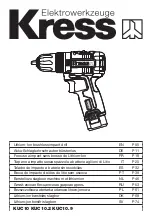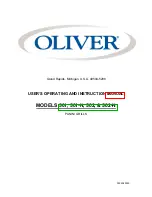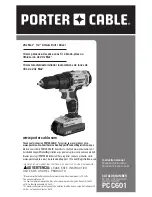
8
EN
COMPONENT LIST
1.
CHUCK
2.
TORSION ADJUSTING RING
3.
MODE SWITCH REGULATING RING
4.
MECHANICAL TRANSMISSION LEVER
5.
BATTERY STATUS
6.
REVERSING LEVER
7.
SOFT HANDLE
8.
BATTERY PACK LOCK KNOB
9.
BATTERY PACK*
10. START/STOP SWITCH
11. LED LAMP
* Not all the accessories illustrated or
described are included in standard delivery.
TECHNICAL DATA
Type Designation
KUC10 KUC10.2 KUC10.9
(C10-designation of machinery, representative
of drill)
KUC10
KUC10.2
KUC10.9
Rated voltage
20V Max**
Rated no load speed
0-500/ 0-1800/min
Torsion adjusting positions
20+1+1
Max torque
30N.m
Maximum clamping
capability
10mm
Max. drilling
capacity
Steel
10mm
Wood
20mm
Brick wall
8mm
Machine Weight
0.95kg
0.78kg
Battery capacity
2.0Ah
/
** Voltage measured without workload. Initial battery
voltage reaches maximum of 12 volts. Nominal
voltage is 10.8 volts.
NOISE INFORMATION
A weighted sound pressure
L
pA
= 78,6 dB(A)
A weighted sound power
L
wA
= 92,6 dB(A)
K
pA
&K
wA
5 dB(A)
Wear ear protection.
WEAR EAR PROTECTION
Vibration total values (triax vector sum) determined
according to EN 62841:
Drilling into metal
Vibration emission value
a
h,D
= 1,916 m/s²
Uncertainty K = 1.5 m/s²
Impact drilling into
concrete
Vibration emission value
a
h,ID
=8,942 m/s²
Uncertainty K = 1.5 m/s²
The declared vibration total value and the declared
noise emission value have been measured in
accordance with a standard test method and may be
used for comparing one tool with another.
The declared vibration total value and the declared
noise emission value may also be used in a preliminary
assessment of exposure.
WARNING:
The vibration and noise emissions
during actual use of the power tool can differ
from the declared value depending on the ways
in which the tool is used especially what kind of
workpiece is processed dependant on the following
examples and other variations on how the tool is used:
How the tool is used and the materials being cut or
drilled.
The tool being in good condition and well maintained.
The use of the correct accessory for the tool and
ensuring it is sharp and in good condition.
The tightness of the grip on the handles and if any anti
vibration and noise accessories are used.
And the tool is being used as intended by its design
and these instructions.
This tool may cause hand-arm vibration
syndrome if its use is not adequately managed.
WARNING:
To be accurate, an estimation of
exposure level in the actual conditions of use
should also take account of all parts of the operating
cycle such as the times when the tool is switched off
and when it is running idle but not actually doing the
job. This may significantly reduce the exposure level
over the total working period.
Helping to minimise your vibration and noise exposure
risk.
Always use sharp chisels, drills and blades.
Maintain this tool in accordance with these
instructions and keep well lubricated (where
appropriate).
If the tool is to be used regularly then invest in anti
vibration and noise accessories.









































